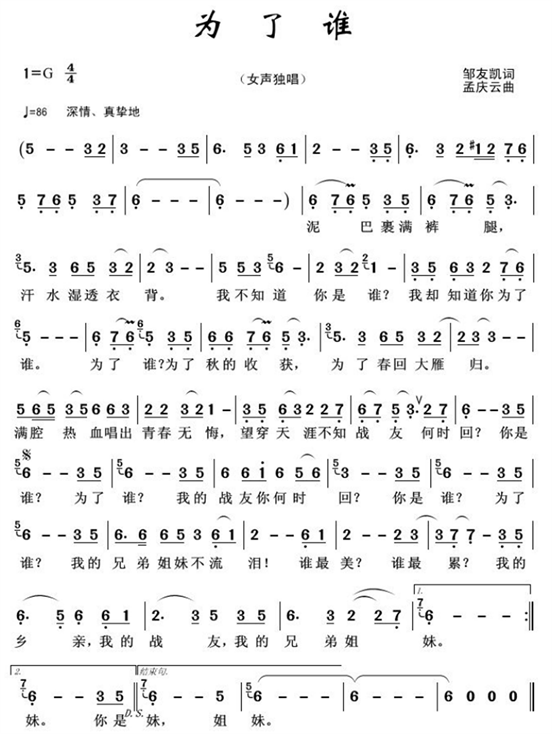
1. Introduction
“Red songs” generally refer to songs that glorify socialism, the Communist Party and the revolutionary movement of the proletariat. Therefore, Chinese red songs can also be called “patriotic songs”. After the reform and opening up, the scope of Chinese red songs was expanded to all songs with the characteristics of the times and reflecting the positive energy of society. As the famous lyricist Yan Su pointed out: “Red songs were born in a long historical environment, grew up with our nation, and melted into the blood of people’s lives. True red songs are rooted in people’s hearts and are sincere, and red songs are a spiritual return and a great love [1] . ” It can be seen that the study of red songs is very necessary.
In December 1978, the Third Plenary Session of the 11th Central Committee of the Communist Party of China was held, breaking through the erroneous shackles of the long-standing “left”, re-establishing the Marxist ideological, political and organizational line, and opening up a new journey of reform, opening up and socialist modernization. In October 1979, the Fourth Congress of Chinese Literary and Art Workers was held, the Ministry of Culture restored the previous structure of art groups, and the Chinese Musicians Association also resumed its organizational work, which encouraged literary and artistic workers to emancipate their minds and clarify their tasks [2] . The superior policy has greatly stimulated the creative enthusiasm of literary and artistic workers, and also provided fertile soil for the birth of excellent songs, and red songs have ushered in a spring of creation.
Most papers on the study of red songs set the time span as the reform and opening up to the present. However, it has been forty years since the reform and opening up, the four decades have changed, and the characteristics and role of red songs have also undergone tremendous changes. Therefore, the author delineates the research range from the reform and opening up to the end of the last century, when reform and opening up improved the lives of Chinese people, and the new century ushered in a prosperous China. The following will elaborate on the four major points of “the embodiment of red songs to real life”, “the characteristics of red songs”, “the melodic characteristics of red songs” and “the role of red songs in the times”, and analyze the characteristics of China’s red songwriting in the past 20 years in combination with political, economic, cultural and social dimensions, aims to provide some shallow help for learners of red songs after the reform and opening up.
2. The Embodiment of Real Life in Songs
Since the reform and opening up, the lives of the vast number of people have undergone rapid changes, and with the continuous changes in real life, the red songs that have emerged are also a “mirror” of real life. Now, select a few relatively representative songs in the range from reform and opening up to the end of the last century for a brief introduction.
The song “On the Field of Hope” (Appendix 1) was written in 1981. After the Third Plenary Session of the 11th Central Committee of the Communist Party of China, the political economy of the whole country gradually recovered, and the people’s enthusiasm for building the great motherland was high. Rural reform has continued to advance, and the living standards of peasants have been significantly improved within a few years. Lyricist Chen Xiaoguang, then editor of the monthly magazine “Song”, truly felt the joy of farmers for the superior policy when he experienced life in rural Anhui Province, and wrote the lyrics excitedly [3] . Then “People’s Musician” Shi Guangnan composed the lyrics with his love for the countryside, and in 1982 the song was handed over to the young singer Peng Liyuan, and the singer’s delicate and soulful interpretation made the song spread rapidly. This is a great red song praising the hometown, depicting a picture full of vitality and hope in the countryside under the reform and opening up.
The song “Amorous Land” (Appendix 2) is also composed by Mr. Shi Guangnan, the song is deep and delicate and has great connotation, expressing infinite affection and attachment to the motherland. The song was written in 1982, in the context of reform and opening up, there was a boom in going abroad in China, and many people wanted to go abroad to seek better development. Lyricist Ren Zhiping did not follow the crowd, but chose to stay in the motherland of “giving birth to me and raising me”. Composer Shi Guangnan and Ren Zhiping share the same firm belief that even if the motherland is not yet strong, the motherland will slowly become rich and strong. The song also won awards after its release for causing widespread resonance. The lyrics are straightforward, “我深深地爱着你,这片多情的土地”, the melody is smooth and beautiful, the rhythm is soothing, the love for the motherland has penetrated deep into the bone marrow, hidden in every mountain road and every river, only in the motherland with blood relatives, can there be a sense of belonging and happiness.
The song “Song of the Seven Sons―Macao” (Appendix 3) was composed in 1998, with lyrics by Wen Yiduo and music composed by Li Haiying, standing in the perspective of the child’s “Macao”, and gently telling the deep love and attachment to his motherland mother through singing. After 300 years of colonization for historical reasons, Macao was finally returned on 20 December 1999, when the Central People’s Government of the People’s Republic of China resumed the exercise of sovereignty over Macao and the Macao Special Administrative Region of the People’s Republic of China was established. [4] Singer Yunlin Yunlin touched the hearts of countless Chinese at home and abroad with her innocent and unrefined voice. The victory of diplomacy depends to a large extent on the improvement of national strength, and Chinese are moved by the “return of the wanderer” while also rejoicing in the progress of their own country.
The song “For Whom” (Appendix 4) was composed in 1998, with lyrics by Zou Youkai and music by MengQingyun. In 1998, the Yangtze River, Nenjiang River and Songhua River experienced basin-wide floods, and a total of 29 provinces across the country suffered floods of varying degrees, affecting 223 million people and causing direct economic losses of 166 billion yuan [5] . Under this major natural disaster, countless Chinese soldiers fought on the front line of flood fighting, they resisted the flood with their bodies, they were not afraid of difficulties and sacrifices, and the heroic feats were forever engraved in China’s history. The song stood from the standpoint of the soldiers, touched countless Chinese sons and daughters through a voice of “为了谁”, and deeply praised the bravery and fearlessness of the people’s soldiers, who regarded death as if they were at home. Every time the melody of “For Whom” sounds, countless Chinese recall the suffering and emotion of 1998, the spirit of “98 flood fighting” will always be in the hearts of the Chinese people, and the national integrity of self-improvement and indomitability will still last for a long time in the long river of time.
3. Lyric Features
3.1. Pay Attention to Personal Emotional Expression
After entering the period of reform and opening up, the traditional red classic songs have gradually undergone new changes. The content of the creation developed from macro to micro, and began to emphasize the personal feelings of each ordinary person [6] .
Picture 1 is an excerpt from “My Chinese Heart”. This lyrical song was written in 1982 with lyrics by Huang Chen and music by Wang Fuling. In 1982, when the Japanese Ministry of Education, Culture, Sports, and Culture approved primary and secondary school textbooks, it openly tampered with the history of aggression against China, arousing Huang Chen’s indignation, so he and Wang Fuling co-wrote “My Chinese Heart”. The protagonist of the lyrics is a wanderer who is wandering abroad, the content of the lyrics expresses a strong longing for the motherland, the protagonist is both excited and proud, proud to have such a “mother”, he will never forget history, will not forget the “mother” when he was a child. “祖国已多年没亲近”, But no matter what he wears, he still has a fiery Chinese heart in his heart. The lyrics adopt a “direct lyrical” expression, and the lyricists directly express their emotions through language in the lyrics, which has unabashed distinctive characteristics. The first lyrics express the protagonist’s infinite longing for the motherland, “河山只在我梦萦”, Even though he was abroad, he was still branded with the Chinese seal. The chorus is more emotional, using a similar arrangement, “Yangtze River, Great Wall, Yellow Mountain, Yellow River” are all symbols of the Chinese nation, these images are “heavy pounds” in his heart, which shows that the motherland plays an important role in the hearts of overseas travelers, and “无论何事不论何地” shows the strong patriotic spirit of overseas travelers. Overseas Chinese around the world, no matter where they are, carry “Chinese love” in their hearts, shed the blood of the descendants of Yanhuang, retain the imprint of the Chinese race, and their personal honor and disgrace are closely linked to the motherland. The lyrics are straightforward, without particularly gorgeous words, and have touched generations of Chinese sons and daughters with their simple words.
3.2. Integrate Into the Characteristics of Life in the New Era
After the reform and opening up, the lyrics were created closer to the lives of the people, adding new era elements on the basis of revolutionary ideas, with a strong atmosphere of life, showing the vitality of the new era.
Picture 2 shows an excerpt from “The Story of Spring”, written in 1992, with lyrics by Jiang Kairu and Ye Xuquan, and music by Wang Yougui, the song is a

Picture 1. “My Chinese Heart”.

Picture 2. “The Story of Spring”.
representative song of reform and opening up, expressing praise for the second generation of the Chinese Communist Party’s leading collective. The song tells two “spring stories”: the first refers to the establishment of the Shenzhen Special Economic Zone by President Deng Xiaoping in the spring of 1979, which is the first paragraph of the lyrics “1979年那是一个春天,有一位老人在中国的南海边画了一个圈”, This circle refers to the special economic zone represented by Shenzhen; The second refers to Chairman Deng Xiaoping’s speech in the south in the spring of 1992, corresponding to the second paragraph of the lyrics “1992年又是一个春天,有一位老人在中国的南海边写下诗篇”, The poem reinterprets the relationship between the market and the planned economy, and stimulates the enthusiasm and initiative of the people of the whole country to start a business. These two events have greatly promoted the development of China’s economy, opened up the window of reform and opening up, opened the prelude to the reform of the Chinese market economy, and laid the foundation for the socialist market economy [7] . With its soulful lyrics and melody, this representative song shows the beautiful picture of HuaxiaShenzhou being “春风吹绿”, China’s economy leaping forward, and the people’s quality of life to a higher level. The lyrics are full of life atmosphere, the metaphors are fresh and appropriate and full of affection, expressing the voice of the people, their support for reform and opening up and their reverence for the party’s second-generation leadership collective. Chinese people have truly transitioned from “standing up” to “getting rich.”
Picture 3 shows an example of “Into a New Era”. The song was written on the eve of the 15th National Congress of the Communist Party of China in 1997, with lyrics by Jiang Kairu, music by Yin Qing, and sung by Zhang Ye, released in April 1997. The song praises the great achievements of the third generation of the Communist Party leadership collective, is full of patriotic spirit, and is a lyrical praise song.
The lyrics are written in the first person, and the first four sentences take the form of “starting and turning”. The first sentence “多想对你表白,我的心情是多么豪迈” is straightforward and sets the tone and style of the whole song’s praise, and the second sentence continues the first sentence “多想对你倾诉,我对生活是多么热爱” shows that after the reform and opening up, the people’s living standards have been continuously improved, people live and work in peace and contentment, and the country has become rich and strong. The third sentence makes a small twist, “中国人意气风发走向新时代”, expressing the infinite longing of the Chinese people for a new era at the turn of the century. The lyrics of the chorus tell “Oriental Red”, “The Story of Spring” and “Into the New Era” respectively, enthusiastically praising the determination and belief of the third generation of the party and the state to build a modern and powerful socialist country. The whole song expresses the people’s yearning for a better life and reflects the upward vitality of the new era.
4. Melodic Characteristics
Different from the red songs that were mostly marching styles before the reform and opening up, after the reform and opening up, most of the red songs of the construction period praised the mountains and rivers of the motherland, praised the true feelings of the world, and condensed personal perspective to express love for the motherland, such as “Song of the Yangtze River” and “Today is Your Birthday”, etc., these songs are mostly soothing in rhythm. At the same time, the heroic and majestic march-style songs were greatly reduced, the melody of the songs was more undulating, more focused on lyrical cheerfulness, beauty and gentleness, art songs revived after a short period of decadence, and more film and television and entertainment popular songs sprang up.
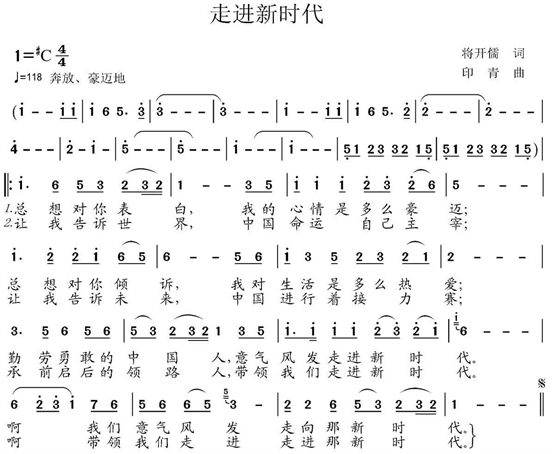
Picture 3. “Into a New Era”.
Picture 4 shows the song “Where the Peach Blossoms Bloom”. The song was released in 1980, composed by Wu Dawei and Wei Guigui, composed by Tie Yuan, and in 1984, singer Tong Dawei brought this song to the stage of the Spring Festival Gala, which caused strong repercussions and was widely circulated among the masses [8] . The melody of the song integrates the folk songs of the Shandong Peninsula, Liaodong Peninsula and other places, narrated in the tone of frontier soldiers, reflecting the great spirit of soldiers leaving their homeland and dedicating themselves to the country for the stability of the motherland, and is another representative repertoire of lyrical songs after the reform and opening up. The whole song has a large melody of ups and downs, twists and turns, and the rhythm is more changeable, using the rhythmic type of sixteenth notes, and also adding triplets, vibrato, thirty-second notes, etc. The song is divided into two parts, the first melody is beautiful and gentle, expressing infinite praise and attachment to the hometown. The second melody is more high and lyrical, expressing the strong patriotic spirit of the border guards. In the last line of the song, the word “边” in “我愿驻守在风雪的边疆” is an octave higher than the previous melody tone, corresponding to the highest note of the whole song, “2”, where the composer adds a free extension mark, and the mood reaches an eruption point at this time, showing the warriors’ love for their homeland and their firm belief in protecting the frontier.
The song “Me and My Motherland” also embodies this melodic characteristic. The song was released in 1985, written by Zhang Quan, composed by Qin Yongcheng, and sung by Li Guyi. Narrated in the first person, the song explores
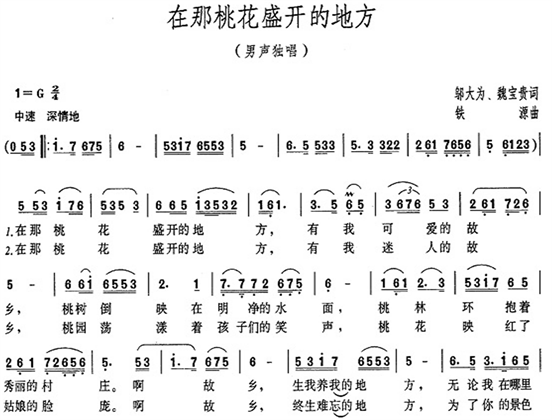
Picture 4. “Where the Peach Blossoms Bloom”.
the eternal relationship between “me and my motherland” and “my motherland and me”, and is a very charming and highly sung lyrical work. The song is divided into two parts, using the three-beat form of 86 beats and 89 beats, the melody is mainly progressive, but there are also many jumps, very beautiful lines and rhythms, stretched smoothly, delicate and sincere emotions, expressing deep attachment to the motherland.
5. The Role of the Song in the Era
In the early days, when the conditions were not ripe in all aspects, the seeds of China’s red songs and revolutionary songs were produced, and these seeds produced rich and diverse forms with the development of the times and the changes in the political environment. After the reform and opening up, the elements of the revolution gradually decreased, adding more connotations of the new era, and many excellent red songs that emerged during this period are still timeless and have an important role in the era.
5.1. The Role of Politics
The early Chinese red songs conveyed a revolutionary spirit that passed on the torch and kept pace with the times, which extended and developed the passionate spirit of the times such as the spirit of fighting floods in the period of peace building. Red songs have a clear political stance, often through narrative, express emotions and other ways to express their attitude towards important historical events, such as “Into the New Era” “我们唱着东方红,当家作主站起来,我们讲着春天的故事,改革开放富起来。继往开来的领路人,带领我们走进那新时代” The leader of carrying on the past and forging ahead leads us into that new era “expresses the determination and will of the party and the country to build a strong socialist country. The red song, which “naturally has the characteristics of socialist ideology”, has also consolidated the unity of the motherland and political stability in its singing.
5.2. Effect on the Economy
After the reform and opening up, the socialist market economy began to develop, and China’s economy continued to grow. The red songs born during this period have a strong spiritual power, and their development and utilization can directly create economic value. Red songs often tell some true stories with beautiful and gentle melodies, and people can also have a deeper understanding of history when listening to and singing red songs, so as to optimize the development environment and promote better and faster economic development. For example, in “The Story of Spring”, the achievements of the second generation of the leadership of the Communist Party of China, the establishment of special economic zones and the conversation with the south have greatly promoted the development of China’s economy, and the socialist market economy flourished after the southern talk in 1992, and this song also inspired the people’s high fighting spirit to create a better future and the innovative spirit of reform.
5.3. The Role of Culture
Red songs are an important carrier of advanced socialist culture. After the Third Plenary Session of the Eleventh Central Committee in 1978, China’s economic development level has developed by leaps and bounds, and economic development has led to the improvement of the quality of life. With the rapid development of mass media, red songs have penetrated into all aspects of social life, affecting people’s lives and practices, making the core socialist values continue to penetrate into the hearts of the people, and patriotic education has been implemented. For example, the lyrics of “Amorous Land read”: “我深深地爱着你,这片多情的土地” and “我耕耘过的田野上,一层层金黄翠绿,我怎能离开这河叉山脊”. These lyrics expound the endless deep affection and love for the motherland and hometown, and when people in the current era sing this song, they can deeply feel the sadness and hope of patriots in the early days of reform and opening up, when the country was not rich and strong. Now, with the struggle of countless Chinese people, China’s international status has gradually improved, and it is forging ahead towards the goal of building a great socialist power, and the people should love our country, follow the leadership of the Communist Party, and build a better life.
5.4. Effect on Society
Red song is a form of cultural communication that transcends class, with a wide range of group audiences, and people gain reason and noble sentiment in singing, promoting the harmonious development of society. For example, the song “For Whom” celebrates the heroes who survived the 1998 flood. Time has flowed and memories will dissipate, but as long as the red songs are sung, people will not forget the touches in the 98 flood fight, and the Chinese nation can still twist into a rope in the face of difficulties, unite and create the future together.
6. Conclusions
Most of the red songs in the early days of socialist construction were marching styles, with lyrics mainly based on slogans, and melodies that were high-pitched and exciting; The banner of reform and opening up ushered in the spring of China’s red songwriting, and songs began to pay more attention to the expression of personal emotions, reflecting the spirit of the times at that time; After entering the new century, China’s national strength has been increasing, its international status has gradually risen, and it has been displayed on the world stage with a more positive and confident attitude, and the red songs at this time tend to praise the great motherland, with cultural confidence and national pride. As far as the connotation of red songs is concerned, the red songwriting from the reform and opening up to the end of the last century has played a role in connecting the upper and lower levels, and the content of the songs has changed from “longing for a better future for the motherland” before the reform and opening up to “national pride” for the current situation of the motherland in the new century. During this period, the hardworking Chinese used their wisdom and hard work to promote the construction of the motherland to rise again, and the creation of red songs also shone with the brilliance of the times.
However, due to the limitations of the author’s thinking and the insufficient red song cases cited, this article still has limitations. For example, in the early days of reform and opening up, there were also obvious differences in the characteristics of red songs at the end of the last century, and the above is slightly rough in the exposition. In subsequent research, we can analyze the changes in the characteristics of songs over time from the perspective of time, and explore the changes in the characteristics of Chinese red songs through more detailed analysis, and feel the interaction between “politics, economy, culture, society” and “red songs”.
Appendix 1: On the Field of Hope
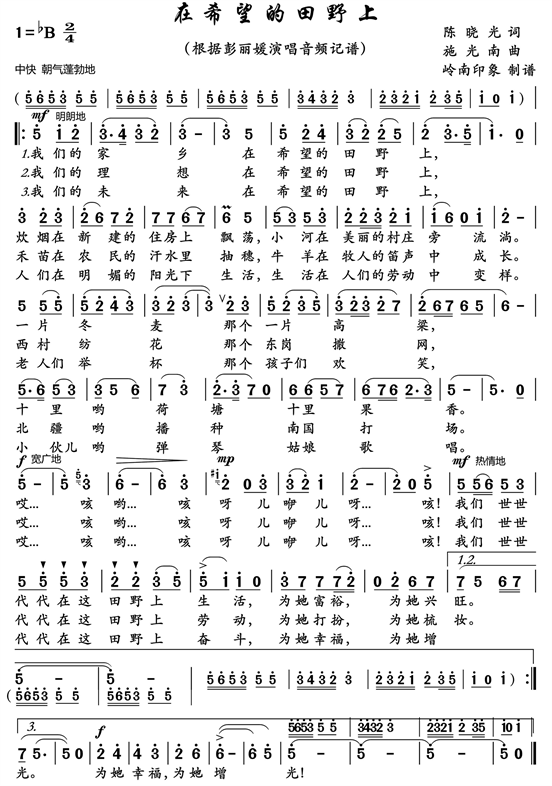
Appendix 2: Amorous Land
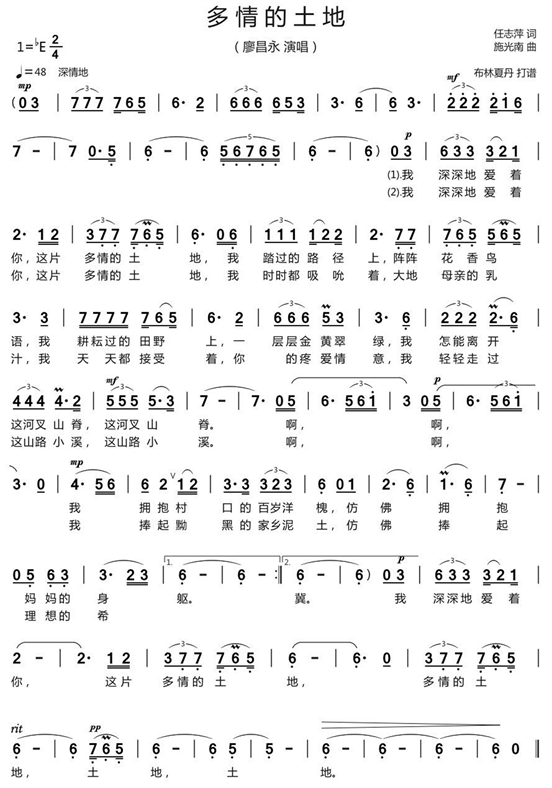
Appendix 3: Song of the Seven Sons―Macao
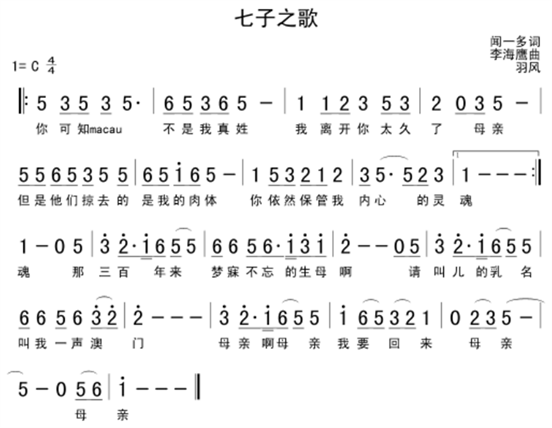
Appendix 4: For Whom
